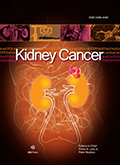Authors: Joshi, Amit | Patel, Ishan | Kapse, Pratiksha | Singh, Manmohan
Article Type:
Systematic Review
Abstract:
BACKGROUND: Treatment of metastatic renal cell carcinoma (mRCC) using traditional schedule (TS, 4/2) of Sunitinib is associated with higher adverse effects compared to the alternate schedule (AS, 2/1 upfront or when switched from TS). OBJECTIVE: This meta-analysis aims to compare the safety, efficacy, and percentage of patients requiring dose reduction or dose interruption between Asian (AP) and non-Asian population (NAP) receiving AS of sunitinib. METHODS: Electronic databases (PubMed, EMBASE, Cochrane Library) were searched to identify studies published in the English language between May 2009- May 2019, which included patients (>18 years) with mRCC receiving AS of
…sunitinib. Data were analyzed using the random effect model and t -test. P < 0.05 was considered statistically significant. RESULTS: Of 1922, 16 studies were included (8 AP, 8 NAP). Among all grade AEs, mucositis (RR:0.22; 95% CI:0.12–0.40), cardiotoxicity (RR: 0.52; 95% CI: 0.31–0.88), nausea (RR:0.21; 95% CI: 0.10–0.44), hand-foot syndrome (RR:0.33; 95% CI:0.13–0.83), rash (RR: 0.52; 95% CI: 0.34–0.79), and aspartate transaminase (RR:0.57; 95% CI:0.33–0.98) were more common in AP. Leukopenia (RR:2.57; 95% CI:1.47–4.49), proteinemia (RR:4.45; 95% CI:2.12–9.33), and stomatitis (RR:4.33; 95% CI:2.6–7.23) occurred more commonly in NAP. Further, PFS was significantly longer in NAP, while longer OS was observed in AP (p < 0.001). Dose reduction was significantly higher in AP than NAP (52.08% vs. 40.6%, p = 0.0088). CONCLUSION: Safety profile of AS of sunitinib was similar with variations in the efficacy, dose reduction between AP and NAP. Sunitinib dose or schedule modification may mitigate AEs and enhance efficacy outcomes in mRCC by extending the treatment duration.
Show more
Keywords: Dose reduction, drug administration schedule, drug toxicity, sunitinib, renal cell carcinoma, Asian
DOI: 10.3233/KCA-210122
Citation: Kidney Cancer,
vol. 6, no. 1, pp. 37-51, 2022





